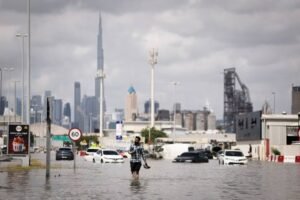Disruption has hit Dubai, a prominent desert city of UAE, as streets are flooded and the city is sinking.
The city is under high alert and all schools, offices, supermarkets, malls have been shut down till April 19.
Two days ago, on April 16th, UAE experienced sudden downpour of torrential rain which stretched till the next day. Consequently, flooding cities across UAE. Footages viral on social media show water seeping into malls and supermarkets of Dubai. Residents and store owners are under distress but the water situation is out of control.
The state run news agency, WAM, reported, “In a historic weather event, the UAE witnessed its heaviest rainfall on record in the past 24 hours. Surpassing anything documented since the start of data collection in 1949” – emphasising the sheer magnitude of rainfall.
Several scheduled flights to Dubai have been cancelled- one of the busiest airport in the world has families stuck at the airport amidst the crisis, with at least 20 people having lost their lives. Life in Dubai has come to a distinct halt and one is yet to take responsibility of it.
Cloud Seeding program as the factor?
Meteorologists are baffled with the incident. While many assume the plausible explanation to be the cloud seeding operation which started in 2002, experts have denied it. They believe climate change to be the major driver behind it.

Clouds are formed when tiny droplets of water in the atmosphere condense around fine dust particles at higher altitudes. As this get concentrated, precipitation occurs in the form of rain or snow. The cloud seeding program is a manual attempt, using generators or planes, to accelerate the formation of clouds. This method is usually adopted by countries which experience drought. This process is closely monitored by meteorologists to prevent untimely rainfall.
Adopting this strategy in early 2000s was a huge step for Dubai, considering the city lacks a well-defined drainage system.
The National Centre of Meterology (NCM), UAE which runs cloud seeding operations have reported that no cloud seeding activity was going on before or during the storm.

Is Climate Change to be blamed?
Experts believe that the alterations in the storm system traversing through the Arabian peninsula and moving across gulf of Oman has caused this intense downpour. According to Esra Alnaqbi, a NCM employee, “A low-pressure system in the upper atmosphere, coupled with low pressure at the surface, had acted like a pressure “squeeze” on the air. That squeeze, intensified by the contrast between warmer temperatures at ground level and colder temperatures higher up, created the conditions for the powerful thunderstorm.”
In the recent years, human activities have accelerated the greenhouse gas(GHG) emissions, raising ocean temperatures. Dim Coumou, a professor in climate extremes at a university in Amsterdam told Reuters, “ Rainfall from thunderstorms, like the ones seen in UAE in recent days, sees a particular strong increase with warming. This is because convection, which is the strong updraft in thunderstorms, strengthens in a warmer world.”











